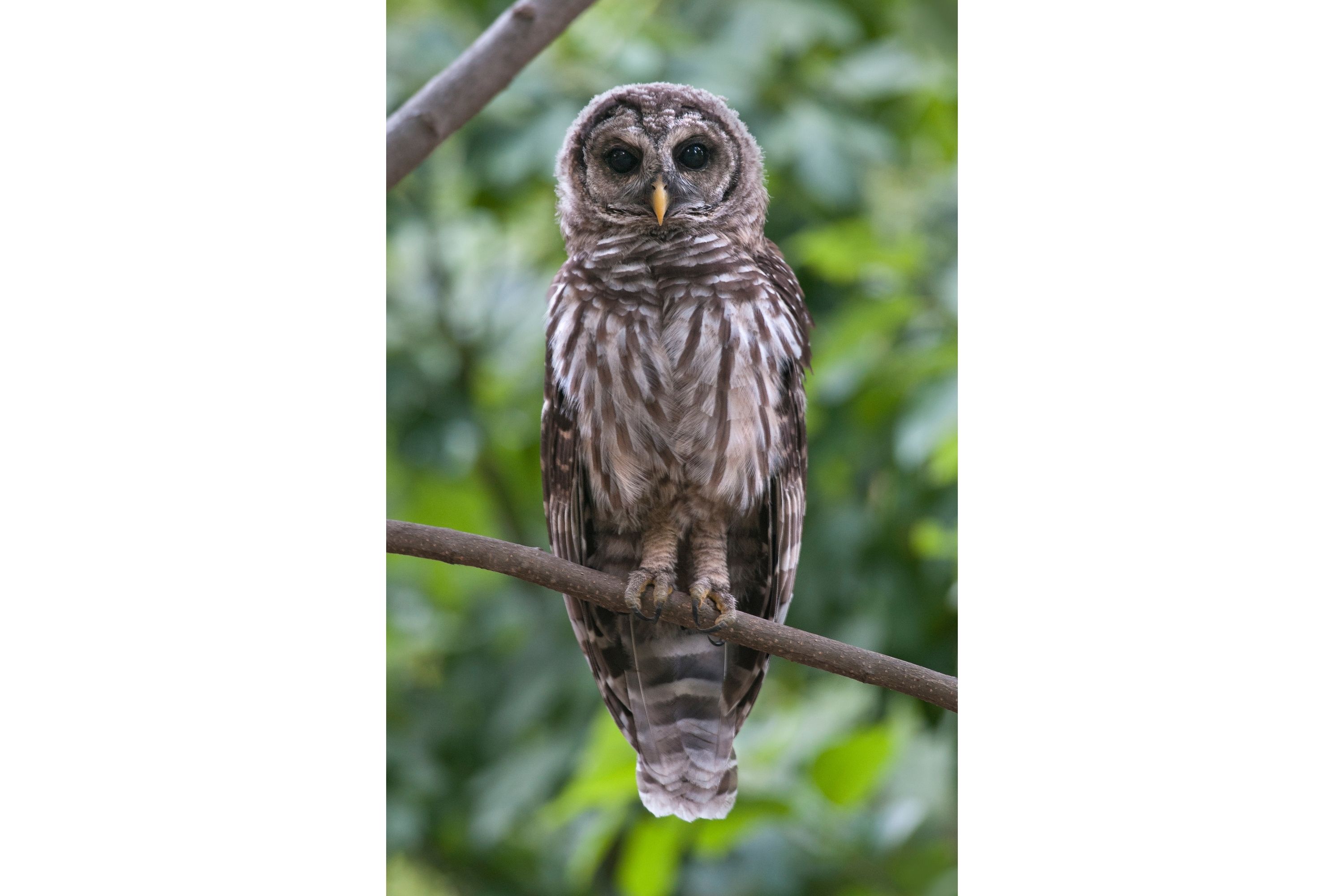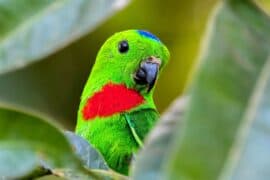Barred Owl
(Strix varia)

Description
Strix varia, commonly known as the barred owl, is a medium-sized owl that belongs to the Strigidae family. These owls are known for their distinctive barred patterns on their feathers and their hooting calls, which are often heard during the night in forests across North America. In this article, we will discuss the various aspects of the barred owl, including their physical characteristics, habitat, behavior, diet, breeding, and conservation status. Physical Characteristics The physical characteristics of the barred owl (Strix varia) are as follows: Size: Barred owls are medium-sized owls, with an average length of 43 to 61 cm (17 to 24 inches) and a wingspan of 96 to 125 cm (38 to 49 inches). Body: The body is mainly brown with a barred pattern on the feathers, giving them their distinctive appearance. The underparts are light-colored. Head: Barred owls have round heads with a pale facial disc and large dark eyes. They do not have ear tufts. Eyes: The eyes are dark brown. Overall, the barred owl has a stout and powerful build, with a broad wingspan and short tail. These physical characteristics allow them to be agile and swift flyers, and efficient hunters of small prey in forests across North America. Habitat The barred owl (Strix varia) is found throughout the forests of North America, from southern Canada to Mexico. They prefer mature forests with a mix of deciduous and coniferous trees, but they can also be found in younger forests, wooded swamps, and riparian areas. Barred owls are known to adapt to suburban areas, such as parks and gardens, where they can find ample prey. However, they still require large areas of intact forest to survive. They are commonly found near streams, rivers, and wetlands, which provide suitable habitat for their prey species, including rodents, rabbits, squirrels, and birds. Overall, the barred owl's habitat is characterized by dense forests with abundant prey and suitable nesting sites, such as tree cavities and snags. Behavior The barred owl (Strix varia) is a nocturnal bird that is most active during the night. They are solitary birds and do not form flocks, although they may be seen in pairs during the breeding season. Barred owls have a distinctive hooting call, which is often described as "who cooks for you, who cooks for you all." The male and female communicate with each other using a range of calls, including hoots, barks, and screams. Barred owls are known for their excellent hearing, which allows them to locate prey even in complete darkness. They have asymmetrical ear openings that are positioned at different heights on their head, allowing them to locate the source of sounds accurately. Barred owls hunt by perching on a tree branch and waiting for prey to pass by, after which they swoop down and capture it with their talons. They are also known to hunt on the ground, particularly in areas with dense vegetation. They feed on a variety of prey, including rodents, rabbits, squirrels, and birds, as well as reptiles, amphibians, and invertebrates. During the breeding season, the male will court the female with hooting calls and by bringing her food. The female will lay between 2 and 4 eggs, which are incubated by both parents for around 28 to 33 days. The chicks are born covered in white down feathers, and both parents care for them until they are ready to fledge at around 5 to 6 weeks old. Overall, the barred owl is a fascinating bird with unique behaviors that are adapted to their nocturnal lifestyle and hunting strategies. Diet The barred owl (Strix varia) is a carnivorous bird that feeds on a variety of prey, including mammals, birds, reptiles, amphibians, and invertebrates. Their diet is diverse and can vary depending on the availability of prey in their habitat. Mammals make up a significant portion of the barred owl's diet, and they are known to feed on a range of species, including mice, voles, shrews, rabbits, squirrels, and bats. They are also known to take larger prey, such as opossums and skunks. Barred owls are opportunistic hunters and will take advantage of any available food source. Birds are another important food source for barred owls, particularly smaller species such as songbirds, woodpeckers, and doves. They have been known to capture birds in flight, but most of their avian prey is taken from perches. Reptiles and amphibians are also part of the barred owl's diet, and they will feed on snakes, frogs, toads, and salamanders. Invertebrates, including insects, spiders, and crayfish, may be eaten during times of food scarcity. Barred owls are sit-and-wait predators that hunt from a perch or fly low over the ground in search of prey. They have keen eyesight and excellent hearing, which allows them to locate and capture prey in complete darkness. They use their powerful talons to grasp and kill prey before swallowing it whole, regurgitating pellets of undigested bones, fur, and feathers. Overall, the barred owl is an adaptable predator that feeds on a wide variety of prey, making it a successful and widespread species in its North American range. Breeding The breeding process of the barred owl (Strix varia) begins in the late winter or early spring, with courtship displays by the male to attract a mate. The male will approach the female with bobbing head movements and hoots, offering her food as a gift. Once a pair has formed, they will choose a nesting site, which is usually a tree cavity, often an abandoned woodpecker hole, or a natural cavity, though they have also been known to use nest boxes. The female will lay 2 to 4 eggs, which she will incubate for 28 to 33 days, while the male brings her food. During incubation, the male will roost nearby and continue to provide food for the female. After hatching, the chicks are covered in white down feathers and are fed by both parents. The female stays with the chicks while the male continues to provide food. The chicks grow rapidly, and their feathers begin to develop at around 3 to 4 weeks of age. At around 5 to 6 weeks of age, the chicks are ready to fledge, or leave the nest, and begin to explore their surroundings. After fledging, the young barred owls continue to rely on their parents for food for several more weeks. The parents will continue to feed and care for them until they become independent, which occurs around 3 to 4 months after fledging. Barred owls are monogamous and typically mate for life. They will return to the same breeding territory each year, and the pair bond is strengthened through shared responsibilities, such as nest building, incubation, and caring for the young. The breeding success of barred owls depends on the availability of suitable habitat and prey, as well as environmental factors such as weather and predation. Conservation Status The conservation status of the barred owl (Strix varia) is currently classified as a species of "Least Concern" by the International Union for Conservation of Nature (IUCN). This means that the species is considered to be widespread and abundant, with no significant threats to its population. Barred owls have a broad range that extends from the eastern United States to the Pacific Northwest of North America. They are found in a variety of forested habitats, including deciduous, coniferous, and mixed forests. The species has adapted well to human-modified landscapes and is often found in suburban and urban areas. While there are no significant threats to the overall population of barred owls, localized declines can occur due to habitat loss or fragmentation, which can limit the availability of suitable nesting sites and prey. Additionally, barred owls are occasionally killed by collisions with vehicles or through predation by other animals, such as great horned owls or raccoons. Barred owls are protected under the Migratory Bird Treaty Act, which prohibits the take, possession, or sale of migratory birds without a permit. The species is also listed on Appendix II of the Convention on International Trade in Endangered Species (CITES), which regulates the international trade of animals and plants to ensure their conservation. Overall, the barred owl population appears to be stable, and there are no immediate concerns about the species' conservation status. However, continued monitoring of population trends and threats to the species is necessary to ensure its long-term survival. Conclusion The barred owl is a fascinating and iconic bird of North American forests. Their distinctive barred pattern, hooting calls, and nocturnal habits make them easy to identify and a popular subject for bird watchers and nature enthusiasts. While not currently endangered, the barred owl is facing threats from habitat loss and invasive species, and conservation efforts are necessary to ensure their continued survival in the wild.
Taxonomic tree:







